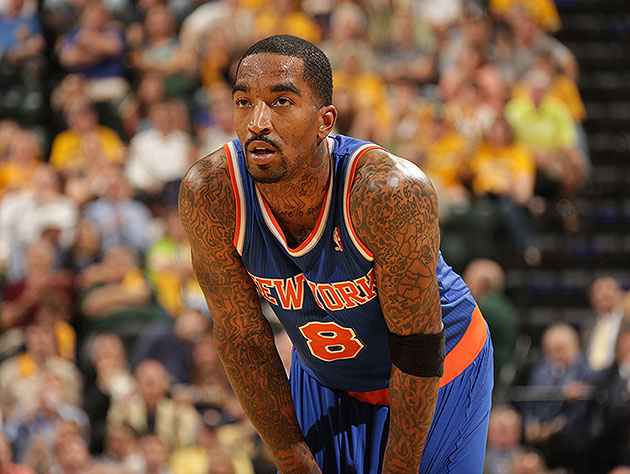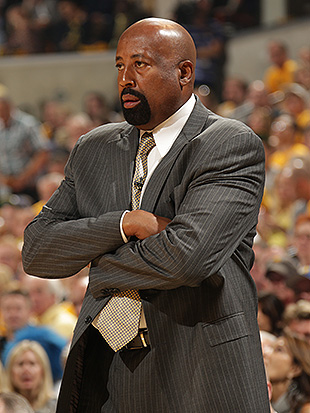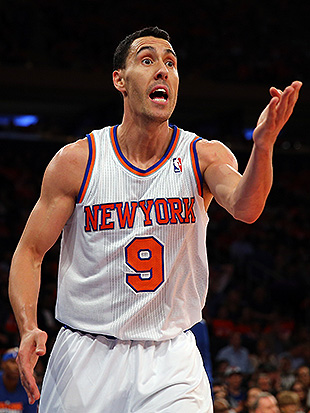
It's no secret that J.R. Smith can't buy a bucket these days — I mean, we've now even got a Twitter account mockumenting his every misfire. He's seemed lost for the last six games, and while he found a bit of rhythm in the fourth quarter of the New York Knicks' Game 4 loss to the Indiana Pacers, there's a chance that any revived scoring touch is either A) a mirage born of the Pacers calling off the dogs after building a 17-point lead or B) too little and too late, now that the Pacers have a 3-1 lead in the best-of-seven series.
Even after getting something with 12 points on 5 for 10 shooting in the fourth, Smith is shooting just 28.1 percent from the field and 23.1 percent from 3-point range against Indiana, extending a cold snap that began with a 3-for-14 return from a one-game suspension for flooring Jason Terry with an elbow. Smith knows his poor play has hampered the Knicks' offense, and he accepted responsibility after Tuesday's loss, according to Howard Beck of the New York Times:
“My frustration level with myself is extremely high,” Smith said. “I take the blame for this whole series.” He made reference to the Boston series, adding: “I haven’t been playing myself. I haven’t played my part. I’ve been letting my teammates down. I’ve been letting my coaches down. It doesn’t feel good.”
Smith also acknowledged the stark difference between the sharp all-around ball he played late in the season and what he's provided recently, according to Newsday's Al Iannazzone:
"I have to play more efficient. I have to rebound the ball. One rebound, two rebounds is not enough. Paul George is out there getting 13, 14 rebounds. As a wing player like myself, I'm pretty much playing the same minutes. It's unacceptable. I have to keep him off the glass. I have to keep the other wings off the glass. Overall just play better."
Yes, he does. That's inarguable. What's sticking in my craw, though, is the "this whole series" part.
Clearly, the Sixth Man of the Year winner who averaged 18 points per game on 42.2 percent shooting and a 35.5 percent mark from 3 would be helpful. The version who averaged 22 a night on 46 percent shooting over the season's final 26 games would be even better. But Smith's far from the sole reason for the Knicks' abysmal play. There's plenty of blame to go around in this series, and you don't have to look very far to find Knicks who also have "to be able to step up and do what [they] do" if New York is to have any prayer of extending the Eastern Conference semifinals to a sixth game.
To wit:
 • Coach Mike Woodson has invited questioning with some of his decisions, including his choice to go big early in Game 4 by starting Kenyon Martin alongside Tyson Chandler in an effort to combat the size and rebounding of Roy Hibbert and David West.
• Coach Mike Woodson has invited questioning with some of his decisions, including his choice to go big early in Game 4 by starting Kenyon Martin alongside Tyson Chandler in an effort to combat the size and rebounding of Roy Hibbert and David West.
The decision made some sense — after all, Indiana dominated the Knicks on the boards in Game 3, grabbing 18 offensive rebounds that resulted in 20 second-chance points. However, by inserting Martin into the starting lineup, sliding Carmelo Anthony to small forward, bumping Iman Shumpert down to shooting guard and moving Pablo Prigioni to the bench, Woodson not only experimented with a configuration that hadn't played a second together this season, per NBA.com's lineup data, but also willingly moved away from the Anthony-at-the-four, two-point-guard-heavy, spread-the-floor, move-the-ball, hunt-open-3-pointers identity that propelled the Knicks to the league's third-best offense this season.
After spending nearly seven months figuring out what his most effective lineups look like, Woodson adjusted away from his team's strengths and into the Pacers', betting that Chandler (who has dealt with knee, neck and illness issues since about mid-March, who has been badly outplayed by Hibbert this series, and who scarcely resembles the force who was arguably the team's most important player earlier this season) and Martin (a middling rebounder at best throughout his NBA career) would make up for their lacking offensive contributions by more gamely battling the Pacers down low. He lost the bet. Indiana outrebounded New York 17-7 in the opening frame, outscored the Knicks 16-4 in the paint, led by seven after 12 minutes, and finished the game with significant edges in rebounding margin and percentage against the Knicks' big lineups.
• Another strategic choice by Woodson — having the Knicks' guards and wings double-team the post, largely in an attempt to quiet Hibbert, who had torched New York for 24 points in Game 3 — backfired badly. Indiana's bigs repeatedly kicked the ball back out upon feeling the double, triggering ball-swings around the perimeter ahead of scrambling Knicks defensive rotations that often resulted in either new opportunities to drive or wide-open 3-point looks. George Hill and Lance Stephenson capitalized, combining to shoot 5 for 13 from beyond the arc, as the Pacers' offense more frequently resembled the Knicks' offense than anything the Knicks have mustered in a month.
 • Woodson doubled down on his dicey adjustments by not only moving Prigioni to the bench, but by all-but fastening him to it throughout Game 4.
• Woodson doubled down on his dicey adjustments by not only moving Prigioni to the bench, but by all-but fastening him to it throughout Game 4.
The Knicks went 20-6 after Woodson moved Prigioni into the starting lineup in mid-March, and the 35-year-old Argentinian has been the only member of New York's rotation regularly knocking down 3-pointers this postseason, hitting at a 43.5 percent clip. New York's offense flows more freely when he's on the court, and his aggressive defense tends to help disrupt opposing backcourts. The numbers bear that out — New York has outscored Boston and Indiana by 18.4 points per 100 possessions when Prigioni is on the floor this postseason, and has been outscored by 5.6 points-per-100 when he sits, according to NBA.com's stat tool.
Prigioni played three minutes and 26 seconds on Tuesday, and didn't see the court at all after the 8:21 mark of the second quarter.
"I'm not going to sit and explain," Woodson said after the game, according to Newsday's Iannazzone. "Right now I'm reaching trying to find combinations that will work."
• Woodson's combinations continue to include guard Jason Kidd, who hasn't made a shot since the first quarter of Game 2 against the Celtics on April 23. In the time since his last make — a three-week period that has encompassed 8 3/4 games, of which Kidd has played nearly 196 minutes — Kidd has missed 17 shots, 10 of which have been 3-pointers, and he hasn't attempted a free throw.
According to the Elias Sports Bureau, he's the second player in NBA history to play at least five minutes in eight straight playoff games without scoring. While Kidd's leadership and "intangibles" were thought to be major assets for a Knicks team aiming for a deep playoff run, he is now providing significantly less production than the much-maligned Mike Bibby did during New York's brief postseason appearance last spring.
• Kidd hasn't been alone, either. As Zach Schonbrun of the New York Times notes, Kidd, Martin and Shumpert played 61 combined minutes in Game 4, took 11 total shots and scored zero total points.
The lack of production from Shumpert, in particular, was killer. The 22-year-old swingman had arguably been the Knicks' best player in the final three games of the Celtics series and the first two against Indiana, averaging 13.4 points per game on 51/44.4/87.5 shooting splits while grabbing just nearly seven rebounds and two steals a night over that five-game stretch, swarming on defense and seeming to have his bounce back.
But he, like the rest of the Knicks, has seemed tentative and unsure in the face of a suffocating Pacers defense, missing 14 of his last 17 shots, including an 0 for 6 mark in Game 4 and five missed 3-pointers. How much of that is owed to the left knee injury he suffered during Game 3, which prompted the Knicks to fly their orthopedic surgeon out to Indianapolis to examine the second-year player, remains unclear. Knicks coach Mike Woodson told TNT's Rachel Nichols during the game that Shumpert's curtailed playing time had nothing to do with the injury, but rather due to his offensive ineffectiveness.
• With no Knick besides Anthony (24 points, albeit on 9 for 23 shooting) and Raymond Felton (14 points, albeit on 7 for 16 shooting) regularly making shots until Smith's late-fourth-quarter surge, Woodson's search for offensive punch continued to steer clear of sharpshooter Steve Novak, who has played just eight minutes in this series and didn't appear Tuesday until Game 4's final minute. He promptly hit a 3-pointer.
Woodson did give a longer look to forward Chris Copeland, with mixed results. The 29-year-old rookie was victimized on back-door cuts twice right after checking into the game, but scored six points in 12 minutes and made two of the three 3-point looks he got; whether Woodson's willing to live with the former in pursuit of more of the latter in Game 5 remains to be seen.
See? There's plenty of blame to go around, J.R. — from your coach to your center to your Yoda point guard, and everyone in-between. And none of that even really deals with the biggest problem:
The Indiana Pacers are really, really good. Maybe in the midst of all this blame, we should also give some credit where it's due.
No comments:
Post a Comment